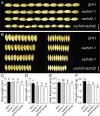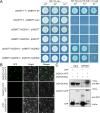The OsZHD1 and OsZHD2, Two Zinc Finger Homeobox Transcription Factor, Redundantly Control Grain Size by Influencing Cell Proliferation in Rice
- PMID: 40119214
- PMCID: PMC11928714
- DOI: 10.1186/s12284-025-00774-8
The OsZHD1 and OsZHD2, Two Zinc Finger Homeobox Transcription Factor, Redundantly Control Grain Size by Influencing Cell Proliferation in Rice
Abstract
Grain size is vital determinant for grain yield and quality, which specified by its three-dimensional structure of seeds (length, width and thickness). The ZINC FINGER-HOMEODOMAIN (ZHD) proteins play critical roles in plant growth and development. However, the information regarding the function in reproductive development of ZHD proteins is scarce. Here, we deeply characterized the phenotype of oszhd1, oszhd2, and oszhd1oszhd2. The single mutants of OsZHD1/2 were similar with wild type. Nevertheless, the double mutant displayed dwarfism and smaller reproductive organs, and shorter, narrower, and thinner grain size. oszhd1oszhd2 revealed a significant decrease in total cell length and number, and single cell width in outer parenchyma; reducing the average width of longitudinal epidermal cells, but the length were increased in outer and inner glumes of oszhd1oszhd2 compared with wild-type, oszhd1-1, oszhd2-1, respectively. OsZHD1 and OsZHD2 encoded the nucleus protein and were distributed predominately in stem and the developing spikelets, asserting their roles in grain size. Meanwhile, yeast two-hybrid, bimolecular fluorescence complementation, and Co-immunoprecipitation assay clarified that OsZHD1 could directly interacted with OsZHD2. The differential expression analysis showed that 839 DEGs, which were down-regulated in oszhd1oszhd2 than wild type and single mutants, were mainly enriched in secondary metabolite biosynthetic, integral component of membrane, and transporter activity pathway. Moreover, it is reliable that the altered expression of cell cycle and expansion-related and grain size-related genes were observed in RNA-seq data, highly consistent with the qRT-PCR results. Altogether, our results suggest that OsZHD1/2 are functional redundancy and involved in regulating grain size by influencing cell proliferation in rice.
Keywords: OsZHD1; OsZHD2; Cell proliferation; Grain size; Rice; Zinc finger-homeodomain.
© 2025. The Author(s).
Conflict of interest statement
Declarations. Ethics Approval and Consent to Participate: Not applicable. Consent for Publication: Not applicable. Accession Number: Sequence data in this study can be found in the Rice Genome Annotation Project data libraries under the following accession numbers: OsZHD1 (LOC_Os09g29130); OsZHD2 (LOC_Os08g37400); OsEXPA13 (LOC_Os02g16730); OsEXPA19 (LOC_Os03g06050); OsEXPB3 (LOC_Os10g40720); OsCYCP4;3 (LOC_Os02g03294); OsCycF1;3 (LOC_Os02g39240); OsCycF2;1 (LOC_Os02g39420); OsCycF2;2 (LOC_Os02g39260); OsCycT1;2 (LOC_Os02g24190); OsTGW6 (LOC_Os06g41850); OsLFS (LOC_Os08g34360); OsPUP4 (LOC_Os01g48800); OsPUP6 (LOC_Os04g49748); OsPUP7 (LOC_Os05g48300); OsPUP10 (LOC_Os04g49739); OsBSR2 (LOC_Os08g43390); OsDSS1 (LOC_Os03g04680); OsXyn1 (LOC_Os03g47010); OsGW2 (LOC_Os02g14720); OsGW8 (LOC_Os08g41940); OsKNAT7 (LOC_Os03g03164). Competing Interests: The authors declare no competing interests.
Figures








References
-
- Barth O, Vogt S, Uhlemann R, Zschiesche W, Humbeck K (2009) Stress induced and nuclear localized HIPP26 from Arabidopsis thaliana interacts via its heavy metal associated domain with the drought stress related zinc finger transcription factor ATHB29. Plant Mol Biol 69(1–2):213–226. 10.1007/s11103-008-9419-0 - PubMed
-
- Bollier N, Gonzalez N, Chevalier C, Hernould M (2022) Zinc finger-Homeodomain and Mini zinc finger proteins are key players in plant growth and responses to environmental stresses. J Exp Bot 73(14):4662–4673. 10.1093/jxb/erac194 - PubMed
Grants and funding
- 32360087/National Natural Science Foundation of China
- 2023GXNSFBA026221/Natural Science Foundation of Guangxi
- 2023MD734148/China Postdoctoral Science Foundation
- 2022J02010/the Natural Science Foundation of Fujian Province, China
- SKL2022007/the State Key Laboratory of Ecological Pest Control for Fujian and Taiwan Crops
LinkOut - more resources
Full Text Sources
Research Materials

